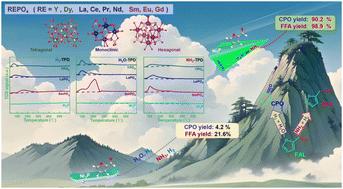H2与H2O或NH3的协同活化可以在Ni2P/REPO4催化剂上实现高效的糠醛升级:镧系稀土磷酸盐†的家族特征
IF 4.2
3区 化学
Q2 CHEMISTRY, PHYSICAL
引用次数: 0
摘要
创新能够协同活化多个小分子的有效催化剂对于促进相应的化学升级具有重要意义。本文通过在Ni-RE-P催化剂中加入稀土元素(RE = La、Ce、Pr、Nd、Sm、Eu、Gd、Dy和Y),将糠醛转化为环戊酮(CPO)或糠胺(FFA),证明了镧系稀土磷酸盐(REPO4)活化H2、H2O和NH3的潜力。ICP-OES、XRD、XPS、SEM和HRTEM表征表明,这些催化剂具有Ni2P负载在REPO4上的结构(Ni2P/REPO4), Ni质量负载在10%左右。在0.5 ~ 1.0 MPa的温和压力下,Ni2P/REPO4催化剂的催化性能比Ni2P/SiO2催化剂显著提高,CPO产率分别为75 ~ 90%和4%,FFA产率分别为67 ~ 99%和22%。这些结果使Ni2P/REPO4成为迄今为止报道的性能最好的催化剂之一。通过同位素示迹、原位红外光谱、TPD-MS测量和DFT计算,Ni2P/REPO4的催化优势可归因于其利用REPO4与H2O或NH3协同活化H2的能力。具体来说,REPO4上的RE和O位点可以作为具有相当分布和强度的酸碱对位点,这对于促进这些小分子的协同活化和促进三分子糠醛升级转化的复杂机制至关重要。这些结果突出了REPO4作为多小分子催化转化的多功能高效组分的家族特征,为设计出组成简单、性能优异的多功能催化体系,推进相应的化学工程应用提供了新的参考。本文章由计算机程序翻译,如有差异,请以英文原文为准。

Cooperative activation of H2 with H2O or NH3 enables efficient furfural upgradation over Ni2P/REPO4 catalysts: a family feature of lanthanide rare-earth phosphates†
The innovation of effective catalysts capable of cooperatively activating multiple small molecules is of great importance for boosting the corresponding chemical upgradation. Here, the potential of lanthanide rare-earth phosphates (REPO4) for activating H2, H2O and NH3 was demonstrated by integrating nine rare-earth components (RE = La, Ce, Pr, Nd, Sm, Eu, Gd, Dy, and Y) in Ni–RE–P catalysts for converting furfural into cyclopentanone (CPO) or furfurylamine (FFA). ICP-OES, XRD, XPS, SEM, and HRTEM characterizations revealed that these catalysts possessed a structure of Ni2P supported on REPO4 (Ni2P/REPO4), with an Ni mass loading of around 10%. Under mild pressures of 0.5–1.0 MPa, significant enhancements in catalytic performance were exhibited by the Ni2P/REPO4 catalysts versus Ni2P/SiO2, such as 75–90% vs. 4% in terms of CPO yield and 67–99% vs. 22% in terms of FFA yield. These results position Ni2P/REPO4 among the top-performing catalysts reported to date. Using isotope tracing, in situ IR spectroscopy, TPD-MS measurements and DFT calculations, the catalytic superiority of Ni2P/REPO4 could be attributed to its ability to cooperatively activate H2 with H2O or NH3 using REPO4. Specifically, RE and O sites on REPO4 could function as acid–base pair sites with comparable distribution and strength, essential for facilitating the cooperative activation of these small molecules and facilitating the complicated mechanism for the three-molecule-involved furfural upgradation conversions. These results highlighted the family feature of REPO4 as a versatile and efficient component for catalytic transformations involving multiple small molecules, providing a new reference for designing outstanding multi-functional catalytic systems with a simple composition to advance the corresponding chemical engineering applications.
求助全文
通过发布文献求助,成功后即可免费获取论文全文。
去求助
来源期刊

Catalysis Science & Technology
CHEMISTRY, PHYSICAL-
CiteScore
8.70
自引率
6.00%
发文量
587
审稿时长
1.5 months
期刊介绍:
A multidisciplinary journal focusing on cutting edge research across all fundamental science and technological aspects of catalysis.
Editor-in-chief: Bert Weckhuysen
Impact factor: 5.0
Time to first decision (peer reviewed only): 31 days
 求助内容:
求助内容: 应助结果提醒方式:
应助结果提醒方式:


